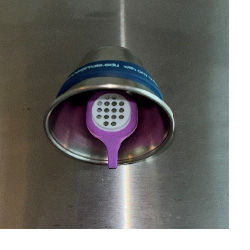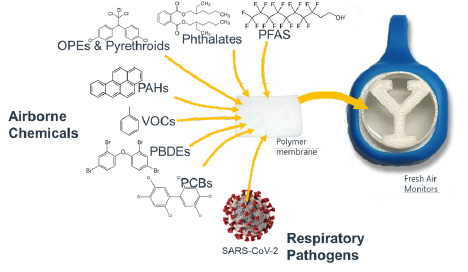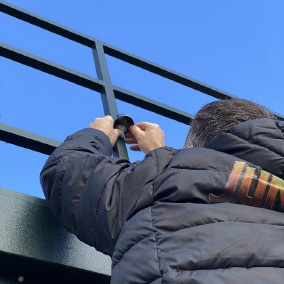.
FAQ on Fresh Air Clips

In compliance with the Clean Air Act in the United States, the U.S. EPA is required to monitor and set National Ambient Air Quality Standards (NAAQS) for the six most commonly observed air pollutants. These six “criteria pollutants”; ground-level ozone (O3), particulate matter (PM10 and PM2.5), carbon monoxide (CO), lead, sulfur dioxide (SO2), and nitrogen dioxide (NO2) are substances with well-studied environmental and public health implications; however, thousands of other chemicals in our air remain unregulated. In an effort to better understand our exposure to air pollution in our everyday environments, Operation Healthy Air scientist and professor at the Yale School of Public Health, Dr. Krystal Pollitt developed the Fresh Air clip. This low-cost and low-maintenance device records traces of hundreds of chemical compounds in our air—allowing Dr. Pollitt and her team to assess how exposure to air pollution varies across communities, identify the communities that bear the highest burdens from poor air quality, uncover previously unknown sources of pollution, and target interventions accordingly.
.
.
Keep reading below for some frequently asked questions about this novel sensor technology:
.
Question 1. What is air pollution and why is it important to study?
Air pollution is made up of gases and particles suspended in the air. These pollutants can be released from natural sources (e.g., volcanic ash) or anthropogenic emissions. Human activity, including cooking, driving, and industrial processes, release air pollutants that can harm the environment and human health. In fact, according to data from the World Health Organization (WHO), 99% of the global population regularly breathes air that violates established WHO air quality standards and using the Air Quality Life Index (AQLI), researchers at the University of Chicago have found that air pollution is responsible for an average loss of two years of life expectancy globally. Mitigating air pollution is an issue of environmental and social justice as well, as low-income and communities of color are disproportionately burdened with poor air quality. Studying air pollution and its implications is essential to improve public health, reduce disease, and promote environmental justice and economic wellbeing.
Question 2. What is a Fresh Air clip?
Fresh Air clips are a passive, low-cost air quality monitoring device, developed by Dr. Krystal Pollitt and her lab at the Yale School of Public Health. These simple devices are “passive” in that they do not require the use of any electronic hardware, specifically pumps or fans that “pull” particles of air into an internal measurement mechanism. Rather, they consist of a sponge-like material that absorbs gaseous and liquid particles secured to a small silicone “clip.” Through Dr. Pollitt’s sampling methods, chemicals present in the air are absorbed into a polymer film and retained in the absorbent material for the duration of the sampling period. After analyzing the samplers in her lab, Dr. Pollitt is able to share valuable information about airborne chemical pollutants and exposure within a given community with decision-makers, other researchers, and community members.
Question 3. How are Fresh Air clips used to monitor air quality?
Due to their small size, lightweight structure, and lack of electronic hardware, Fresh Air clips can be deployed as a stationary monitor or as a wearable device. While Dr. Pollitt and her team have conducted previous research deploying the samplers on wristbands to monitor individual-level exposure to pollution, Earthwatch’s projects have used the clips as a stationary monitor to assess community-level air quality. For these projects, the devices are typically kept at an outdoor site for about two weeks. After the monitoring period, the clips are returned to Dr. Pollitt’s lab for chemical analysis. The analysis reveals the presence and levels of hundreds of chemicals. Dr. Pollitt and her team are then able to determine the sources of pollution and which individuals and communities are most heavily impacted by exposure.
Question 4. What value do Fresh Air clips provide?
Traditional methods for monitoring air quality involve the use of large regulatory monitors, which are maintained by state and national environmental regulatory agencies. These networks of ambient air monitoring stations contribute valuable data to forecast daily air quality and assess long-term trends; however, deploying them at a wider scale is inhibited by the high costs of the equipment (typically tens or hundreds of thousands of dollars) and human resources (technicians, scientists) required to maintain them. These barriers result in data that is focused on a small number of pollutants and regulations that are based on just a few monitoring stations in huge geographic areas.
Fresh Air clips address these issues by massively increasing both the breadth and depth of air quality data that researchers can collect. In addition to their low cost, they require little maintenance and contain no electronic hardware—enabling scientists to deploy them across a range of different communities. Additionally, using Dr. Pollitt’s passive sampling methodology, Fresh Air clips collect data on thousands of airborne chemicals. Fresh Air clips fill critical gaps in data and knowledge, offering insights into the levels and sources of airborne chemicals and how exposures vary across and between communities.
Question 5. What types of chemicals do Fresh Clip detect?
Fresh Air clips collect traces of thousands of chemicals in the air. Monitoring these chemicals provides researchers with valuable insights into the sources of poor air quality in communities. Some examples of chemicals include polycyclic aromatic hydrocarbons (from fossil fuel combustion), organochlorides (from pesticides), polybrominated diphenyl ethers (flame retardants in building materials and insulation), and phthalates (plasticizers found in many consumer products). While this list is not exhaustive, Fresh Air clips have produced extensive data on airborne chemicals that we are exposed to in our everyday lives. In 2020, after the outbreak of the novel coronavirus, Dr. Pollitt adapted her Fresh Air technology to measure exposure to SARS-Cov-2, the viral precursor to COVID-19.
.

Figure 2: Fresh Air Clip and examples of the airborne chemicals that it can detect.
.
Question 6. How is Fresh Air clip different from other low-cost sensors?
Mainstream low-cost sensors typically only detect a small number of air pollutants (in most cases, only particulate matter) and usually require a stable electrical source and wireless internet network. Fresh Air clips, on the other hand, detect air pollutants without the use of electricity or Wi-Fi, which allows them to collect information about air quality on a wide scale and capture hyperlocal measurements, which had previously been inaccessible. Additionally, passive chemical sampling (as opposed to traditional methods) lets researchers evaluate thousands of chemical pollutants—expanding sampling well beyond the small number of criteria pollutants and particulates that have tended to dominate air quality research.
Question 7. How do Fresh Air clips contribute to environmental justice research?
In addition to their scientific value, Fresh Air samplers have been a meaningful tool for advancing environmental justice. Historically, exposure to poor air quality has disproportionately impacted low-income communities, communities of color, and other marginalized and frontline populations. Furthermore, the political power and financial resources necessary to take action have not been equitably allocated to these most at-risk groups. Fresh Air clips can and have been deployed in environmental justice communities—helping residents and community-based organizations better understand their exposures and the actionable steps that they can take to protect public health.
Question 8. Where have Fresh Air clips been deployed?
Earthwatch and Dr. Krystal Pollitt’s group at the Yale School of Public Health have partnered together to deploy Fresh Air clips on three continents and plan to expand the scope of this research in the near future.

In 2021, in partnership with EY, Fresh Air clips were sent to 50 EY employees across the United States to install in their homes. Later in the year, 10 samplers were installed outside of Perth, in Western Australia, with the support of the Alcoa Foundation. Additionally, 136 sensors were deployed for two weeks across four cities in Western Europe; Brussels, London, Madrid, and Paris, supported my Moody’s Foundation. Most recently, in the summer of 2022, nearly 30 Fresh Air clips were deployed across the Bay Area in Northern California, supported by Coupa Software.
In addition to these Earthwatch-supported deployments, Dr. Pollitt and her team have used Fresh Air clips as wearable wristbands in China, India, South Africa, and elsewhere across the United States. This has enabled her team to measure personal level exposures, uncovering data on how airborne pollutants differ individual by individual. These research efforts have greatly expanded our ability to compare chemical exposures and air pollution in diverse cities and communities across the world.
.
Sign up for the Earthwatch Newsletter
Be the first to know about new expeditions, stories from the field, and exciting Earthwatch news.
.
.
.